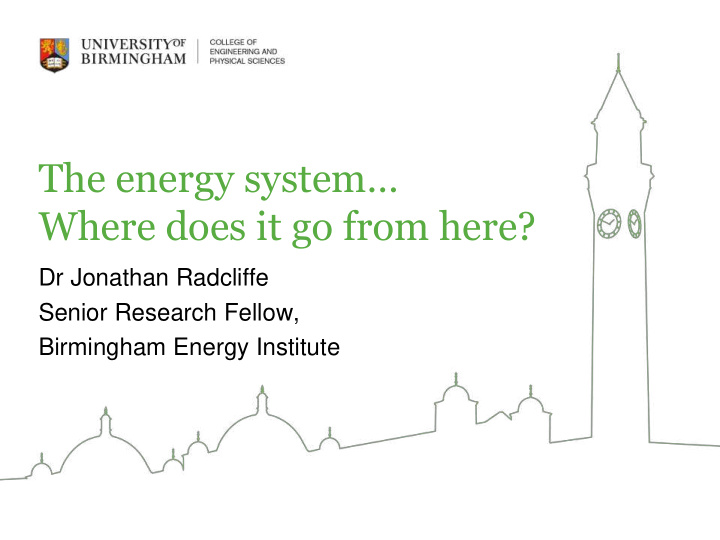



The energy system… Where does it go from here? Dr Jonathan Radcliffe Senior Research Fellow, Birmingham Energy Institute
One view of the energy system - where we use energy Other Industry (mostly 18% agriculture) 14% Domestic 28% Transport 40%
Slightly more refined… Sources: National Grid (electricity & gas [LDZ offtake]); DfT (petroleum products for transport, quarterly data); Gridwatch (wind and solar [solar from Nov 2016])
What’s the challenge? ‘Decarbonising the energy system’ risks oversimplifying the challenge, reducing it to a technological problem. Consider rather ‘Decarbonising UK’s energy system s ’: multi -scalar, multi- vector socio-technical system of systems. • Central + multiple local infrastructures • Mix of fuels providing energy services to provide utility, thermal comfort, mobility Driven by policy aims, including • Environmental targets – CO2 and other pollutants • Social welfare – fuel poverty and consumer costs • Economic growth – innovation for industrial strategy, costs for industry • Increasing reliability & reduced imports Effective policy needs to be reshaped around long-term aims that recognise the complexity.
National Several technical options for providing heat and storage, too narrow a framing of the system risks making the wrong choices. Distributed generation could rise significantly (50% by 2030 in this scenario), but large-scale generation still dominates. National Grid, Future Energy Scenarios 2017: http://fes.nationalgrid.com/fes-document/
Cornwall ‘Sunshine tariff’ trialled, shifted demand 13%
Heat demand and wind generation in Scotland Sources: National Grid (gas), DECC Energy Trends (2016) Scottish Govt Climate Change Plan - 90% emission reduction target by 2050
Birmingham • Carbon Roadmap has a commitment to reduce emissions 60% by 2027. • Failure of Birmingham Energy Savers Scheme with demise of Green Deal • BCC establishing a municipal energy company.
Where are we now? No evidence that thinking is going beyond the current paradigm: HMG/Ofgem ‘Upgrading Our Energy System; Smart Systems and Flexibility Plan’ (2017) – addresses short term barriers, but focused on electricity and central policy/regulation HMG ‘Building our Industrial Strategy’ Green Paper (2017), references energy system challenges Faraday Battery Institute launched with £65m from Industrial Strategy Challenge Fund, as part of £245m investment – prioritises applications for auto sector. Which is fine, but misses a greater opportunity for the system and industry…
Existing energy storage in the UK Coal 1Mt coal stored next to a power station = 3,000 GWh e (about two months output at 2GW) Gas UK gas storage ̴ 50,000 GWh Electricity Total UK Pumped hydro storage = 28GWh e Thermal One domestic hot water cylinder = 6kWh th aggregated in UK: 14m tanks = 84GWh th
UK public sector funding for energy storage technologies has been patchy IEA energy Funding 2000 – 2009 category (£k) Energy storage 7,551 Wind energy 25,816 Solar energy 37,721 Ocean energy 39,511 Relatively small amounts for thermal and large-scale Generation Integrated energy storage that could be important. Source: UKERC Research Register
Innovation in energy storage Near-term storage services likely to be over timescales of seconds – minutes, but high penetrations of “inflexible” generation means increasing need for large stores of energy over hours – days. There has been a lag in support, and lack of vision across the innovation landscape, which is needed to enable the appropriate technologies to be developed. Other than electrochemical batteries, overall level of funding for energy storage, while increasing, is low compared to other technologies, and fragmented. It is not sufficiently supported by policy to provide confidence to private sector investors. From Taylor and Radcliffe, paper presented at the 2016 BIEE Research Conference “Innovation and Disruption: the energy sector in transition ”
Technology choices Our approach will drive support for intervention, e.g. Energy storage: electrical/thermal behind-the-meter or generation- integrated, interseasonal Heat: H2, district heating, heat pumps, efficiency, behaviour change More on heat options by MacLean et al, at http://www.ukerc.ac.uk/network/network-news/decarbonising-the-heat-sector.html
Evidence-informed policy making Using evidence to inform decisions is a central tenet of the policy making process in the UK. But, in practice , many other factors shape the outcomes, e.g. political expediency; o restricted time frames and budgets; o perceptions, ideas and competency of the actors involved… o
Evidence use in energy policy making There are gaps in our understanding of the actors from different sectors (public, private, research) involved in energy policy making operating at each scale; the ways in which they interact with each other; the nature and quality of such interactions; their impact on outcomes in relation to energy policies and strategies. Of particular interest: the role, identity and resources of organisations which (can) act as intermediaries within the networks of energy policy making.
Concluding thoughts Local commitments to emissions reductions, but priorities, resources (+ opportunism) driving choices; may compete with national aims Risk that lack of coordination prevents using benefits of diversity to be flexible LAs/DAs limited ability to pursue policy objectives Decision-making across scales may be limited by policy processes rather than energy system analyses
Summary Can we reconceptualise the energy system, from one based on fuels/vectors, to one in which policy, regulation and business models are built around the provision of services to consumers Pathways for energy system decarbonisation must recognise diversity in the system and how combinations of multiple fuels and vectors will be used for power, heat and transport. Innovation in technology and policy required; perspective of the energy system may lead to different choices, for e.g. heat, storage. Need to examine the policy-making process across scales to ensure it can be effective and able to meet goals.
Thank You and to colleagues at UoB (Dan Murrant, Yongliang Li, Timea Nochta) and to EPSRC for funding current projects: Energy Storage SUPERGEN Hub Consortium for Modelling and Analysis of Decentralised Energy Storage (C-MADEnS) Realising Energy Storage Technologies in Low-carbon Energy Systems (RESTLESS) Across Scale in Energy Decision Making (Ascend) Generation-Integrated Energy Storage: A paradigm shift j.radcliffe@bham.ac.uk @UKEnergyInnov8 http://www.birmingham.ac.uk/energy
Recommend
More recommend